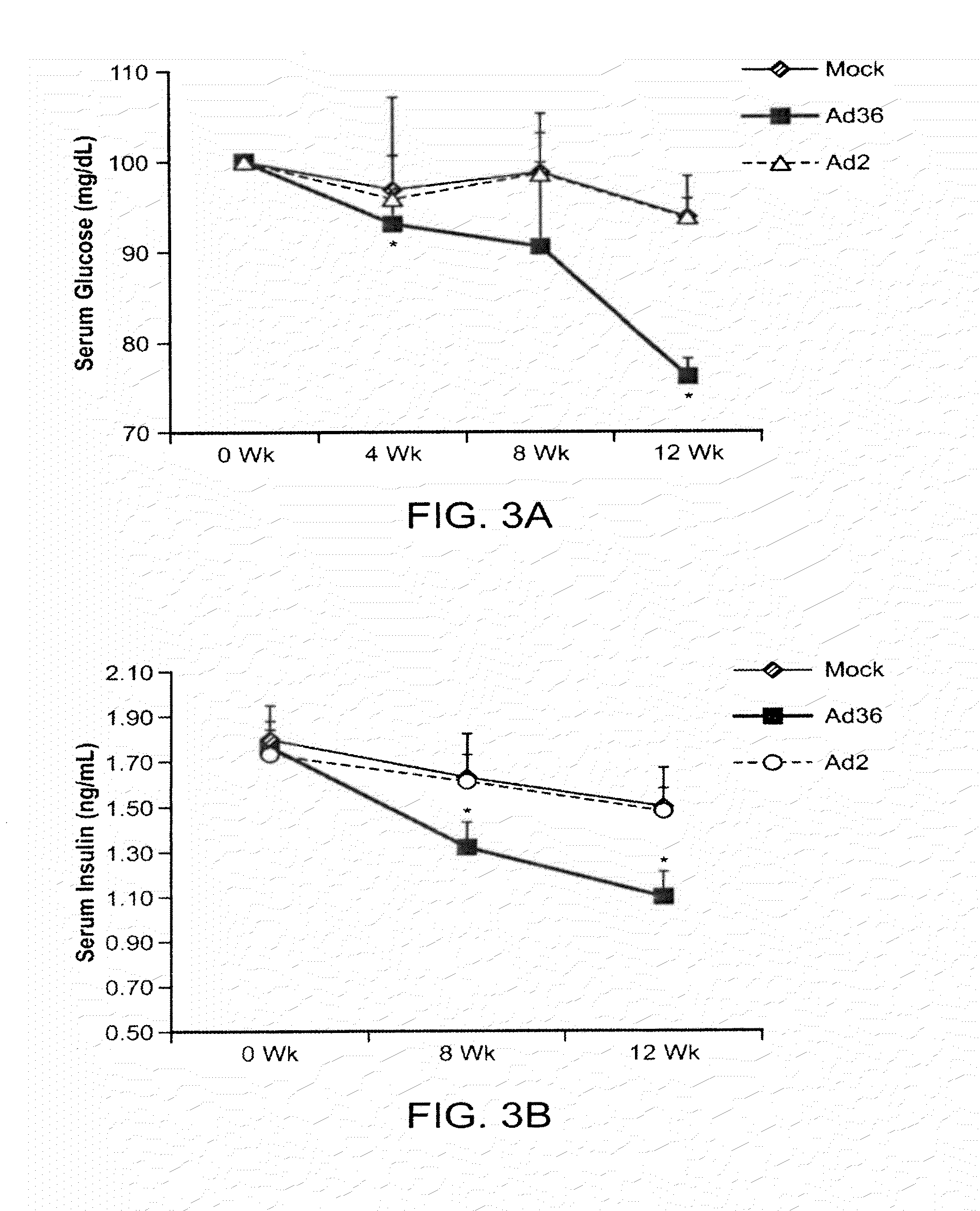Adenovirus AD36 E4 ORF1 Protein For Prevention and Treatment of Non-Alcoholic Fatty Liver Disease
a technology of fatty liver disease and adenovirus, which is applied in the direction of peptide/protein ingredients, dsdna viruses, metabolic disorders, etc., can solve the problems of poor glycemic control, liver dysfunction, and difficulty in achieving sustained improvement in diet or obesity, and achieves the effect of reducing the incidence of liver pathology and improving liver function
- Summary
- Abstract
- Description
- Claims
- Application Information
AI Technical Summary
Benefits of technology
Problems solved by technology
Method used
Image
Examples
example 1
Ad36 and Humans
[0087]Serum samples from four cohorts were screened for Ad36 antibodies as an indicator of past infection. The cohorts were: A) HERITAGE Family Study (49) (n=671, White and Black men and women) B) PBRC (Pennington Biomedical Research Center) Study (206 White and Black men and women), C) MET Study (50, 51) (n=45 pre-pubertal White and Black boys and girls), D) VIVA LA FAMILIA study (52) (585 Hispanic boys and girls). The prevalence of Ad36 antibodies was 13%, 18%, 22% and 7% in the HERITAGE, PBRC, MET and Viva La Familia studies, respectively. Various measures of better glycemic control (including insulin sensitivity or disposition index) were significantly associated with Ad36 infection in these cohorts, independent of age, gender, race and adiposity (e.g Tables 1 & 2 show the PBRC and MET cohorts). Importantly, the association of Ad36 with better glycemic control was remarkably consistent across these cohorts of diverse age groups and races of over 1,500 individuals....
example 2
Ad36 Improves Insulin Sensitivity in Chow-Fed Mice
[0088]Age, weight, and body fat matched female C57BL / 6J mice were mock infected or infected with Ad36 or Ad2 and maintained on a standard chow diet. Four week old female C57B6 / 6J mice were purchased from The Jackson Laboratories (Bar Harbour, Me., USA). After 1 week of acclimatization, total body fat was determined by Bruker Minispec mq10 NMR (Nuclear Magnetic Resonance) analyzer. Mice were divided into three groups matched for body weight and body fat and inoculated intra-nasally, orally and intraperitoneally with 107 PFU of Ad36 (N=3) or Ad2 (a common human adenovirus used as a control; N=4) or mock infected with tissue culture media (n=6). The mice were on a 12 hour light-dark cycle at 25° C. and housed in micro-isolator cages under Biosafety level 2 containment in one room and offered ad libitum access to water and rodent chow (Purina LabDiet 5001).
[0089]The three groups of mice showed no difference in total body weight during a ...
example 3
Ad36 Improves Hyperglycemia in High-Fat Fed Mice
[0093]This experiment investigated whether Ad36 has similar effects in mice made diabetic with a high fat (HF, 60 kcal %) diet that causes diet-induced hyperglycemia.
[0094]Age, weight, and body fat matched male C57BL / 6J mice (14 weeks old) fed a HF diet for the prior 8 weeks developed a diabetic state as evidenced by high fasting serum glucose levels (>200 mg / dL). At this point, mice were either mock infected or infected with Ad36, or Ad2. By 20 weeks pi, all three groups displayed similar cumulative food intake, as well as total body weight and fat pad masses (Table 5, FIG. 2). Fourteen week old male C57B6 / 6J mice were purchased from The Jackson Laboratory (Bar Harbour, Me., USA), who were fed a high fat (60% kcal) diet (Research Diets Inc. D12492i) starting at six weeks of age. Upon 1 week acclimatization, baseline body fat was determined by NMR and mice were divided in three groups (n=10 per group) matched for body fat and body weig...
PUM
| Property | Measurement | Unit |
|---|---|---|
| pH | aaaaa | aaaaa |
| thickness | aaaaa | aaaaa |
| temperature | aaaaa | aaaaa |
Abstract
Description
Claims
Application Information
 Login to View More
Login to View More - R&D
- Intellectual Property
- Life Sciences
- Materials
- Tech Scout
- Unparalleled Data Quality
- Higher Quality Content
- 60% Fewer Hallucinations
Browse by: Latest US Patents, China's latest patents, Technical Efficacy Thesaurus, Application Domain, Technology Topic, Popular Technical Reports.
© 2025 PatSnap. All rights reserved.Legal|Privacy policy|Modern Slavery Act Transparency Statement|Sitemap|About US| Contact US: help@patsnap.com



